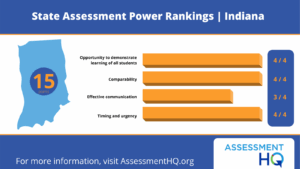By Dale Chu

The time for states to make their case for waiving out of testing this spring is likely at an end, but the period for mischief-making is just getting started. In the coming weeks and months, in addition to examining assessment waivers, I’ll be using this space to look at how states have encouraged or discouraged schools and families—actively or subtly—from testing their students, as well as how they’re using assessment data to help get students back up to snuff. Sadly, there are some lousy and lazy practices being effectuated, but let’s start with a bit of positive news from the Hoosier state, which has taken a pole position on using state testing data to help drive their education recovery efforts.
While some parts of the country are still weighing the risk of returning to in-person schooling, most of Indiana’s schools have been open for the majority of the school year. Early on, state officials voiced their support for proceeding with state exams, regardless of any flexibilities offered by the federal government. Partly as a result, the state has seen strong participation on assessments thus far, with 97 percent of third graders completing the state’s standardized reading test earlier this spring.
Indiana is more than halfway through its testing window, which is slated to close on May 14th. There’s a lot to like about how Hoosiers are handling state assessments during the pandemic, but the pièce de résistance is Indiana’s learning loss study (more on that below).
Opportunity to demonstrate learning of all students — Score: 4
Indiana has no formal mechanism for students to opt-out of the state test. State leaders have held firm on endeavoring to assess as many students as possible. Earlier this year, the house education chair said, “We need to [test] so we have some idea as to where our kids are and… how great the learning loss problems are. [Testing] is more imperative today than it was last year.”
Some of the anecdotal evidence thus far has been encouraging. One of the state’s largest districts reported 84 percent participation on the first day of testing. Not to be outdone, a local charter management organization recently reported 92 percent participation among its students.
Comparability — Score: 4
It seems unlikely that any state will hit the typical 95 percent participation bar that allows for optimal comparability across schools and student groups, but Indiana looks to be doing better than most vis-à-vis its assessment efforts.
Effective communication — Score: 3
Although dozens of districts called for the cancellation of state testing, the state’s department of education told schools and districts that testing would continue as scheduled.
Timing and urgency — Score: 4
The state recently passed HB 1008 and HB 1514, which, taken together, aim to study and address learning loss. The Center for Assessment will review state data and provide an initial report in July so schools can have more to work from before the start of the next school year. Among other things, the report will examine student achievement and growth, gaps among student groups (including ELL and special education students), and provide recommendations regarding interventions.
It’s hard to overstate the potential benefits of Indiana’s approach. Unlike most other states, which have started by addressing solutions (e.g., more funding for tutoring and summer school) in a “ready, fire, aim” approach, Hoosiers are looking to define the problem first. By setting July as the deadline, Indiana appears to recognize the urgency of the moment, and the importance of having better information to inform their spending and resource allocation decisions.
What remains to be seen is whether the final report will be user-friendly. State reports can often be wonky documents, but in light of the need for actionable data quickly, erring on the side of being easy-to-use would increase the likelihood of broader adoption by schools and districts. This will be worth keeping an eye on.
